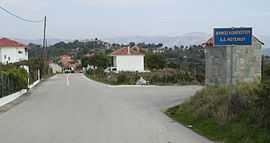Foteino, Arta
| Foteino Φωτεινό | |
|---|---|
 | |
| Location | |
 Foteino | |
| Coordinates | 39°8′N 21°6′E / 39.133°N 21.100°ECoordinates: 39°8′N 21°6′E / 39.133°N 21.100°E |
| Government | |
| Country: | Greece |
| Administrative region: | Epirus |
| Regional unit: | Arta |
| Municipality: | Nikolaos Skoufas |
| Municipal unit: | Kompoti |
| Population statistics (as of 2001)[1] | |
| - Area: | 8.953 km2 (3 sq mi) |
| - Density: | 0 /km2 (0 /sq mi) |
| Community | |
| - Population: | 374 |
| Other | |
| Time zone: | EET/EEST (UTC+2/3) |
| Postal code: | 471 00 |
| Telephone: | 26810 |
Foteino (Greek: Φωτεινό [![]() pronunciation /fotinó/ (help·info)]) is a village (community) in the municipal unit of Kompoti in the regional unit of Arta, Greece. In 2001 its population was 374.
pronunciation /fotinó/ (help·info)]) is a village (community) in the municipal unit of Kompoti in the regional unit of Arta, Greece. In 2001 its population was 374.
History
The old name of the village, Hósiana (Greek: Χώσιανα), appears for the first time in 1696, in a historic document in which the villages of Arta asked the Venetian Republic for protection from pirates.[2]
In 1899, a new church was built by destroying a small old one, dating to the early 12th century[3]
The village was constituted as a separate commune with the 186/10.08.1947 government gazette (ΦΕΚ). Until then it was part of the commune of Ano-Petra.[4] With ΦΕΚ 195/23.07.1953, its name changed from Hosiana to Fotino,[5] and with law 2539/1997, as part of the Kapodistrias reforms, the commune became a municipal district of the municipality of Kompoti.
Gallery
-

Fotino
-

Fotino - Amvrakikos view
-

Fotino - Meyarhi View
-

Fotino - Peta View - October
-

Fotino - Peta View - June
See also
- Kompoti
- Sellades
- Menidi
- Ambracian Gulf
- Ionian Sea
- Arachthos River
External links
Footnotes
- ↑ De Facto Population of Greece Population and Housing Census of March 18th, 2001 (PDF 793 KB). National Statistical Service of Greece. 2003.
- ↑ Kaselouris, Lampros Christos. 1980. Historic And Folklore of Arta. Athens. Page 101
- ↑ Kaselouris, Lampros Christos. 1980. Historic And Folklore of Arta. Athens. Page 104
- ↑ Kaselouris, Lampros Christos. 1980. Historic And Folklore of Arta. Athens. Page 117
- ↑ Kaselouris, Lampros Christos. 1980. Historic And Folklore of Arta. Athens. Page 98
| ||||||||||||||